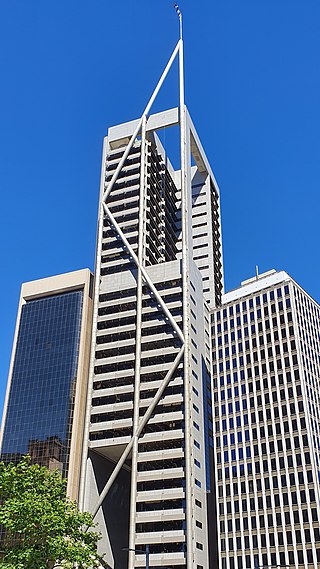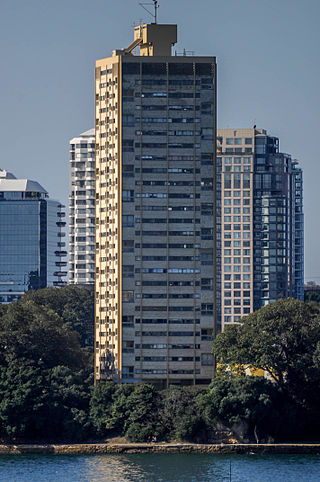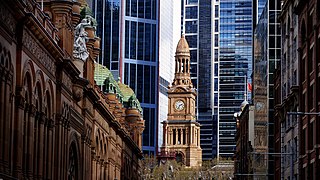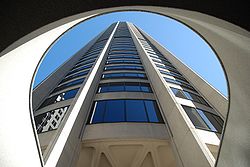
The International Finance Centre is a skyscraper and integrated commercial development on the waterfront of Hong Kong's Central District.

25 Martin Place is a skyscraper in Sydney, Australia. Originally named the "MLC Centre" after MLC Limited, and still commonly referred to by that name, in 2021 the name was removed by its owner, Dexus, which now refers to the building simply by its street address of 25 Martin Place.

Riparian Plaza is a 53-storey skyscraper located in the central business district of Brisbane, Queensland, Australia. The building stands at 250 m (820 ft) in height to its communications spire and 200 m (660 ft) to its roof. It was Brisbane's tallest building until it was surpassed by Aurora in 2006 and is a particularly iconic building on the Brisbane skyline. It is a mixed use building, with 11 car park levels from the ground up, 25 commercial levels, and 12 residential levels originally housing 50 penthouse apartments.

108 St Georges Terrace or South32 Tower is a 50-storey office tower in Perth, Western Australia. Completed in 1988, the building measures 214 metres (702 ft) to its roof and 247 metres (810 ft) to the tip of its communications antenna. It was the tallest building in Perth from its completion in 1988 until 1992 when it was overtaken in height by Central Park. As of 2023, it is the third-tallest building in the city. The concrete tower has a distinctive profile, with a triangular plan.

Waterfront Place is an office building in the Brisbane central business district in Queensland, Australia. It is located at 1 Eagle Street, beside the Brisbane River. It was constructed by renowned Queensland builder and developer F. A. Pidgeon and Son who led the projects development in a joint venture with Folkestone Limited. Construction was completed in 1989. The building stands 162 metres (531 ft) tall.

Capita Centre, is now known as 9 Castlereagh St Sydney, is a skyscraper in Sydney, Australia. Located at 9-11 Castlereagh Street, it is 183 metres (600 ft) tall from spire and 158 metres (518 ft) tall from roof. The building was designed by Harry Seidler & Associates in 1984 and completed in 1989. The building won Royal Australian Institute of Architects (NSW) merit award 1991.

Chifley Tower is a skyscraper in Sydney, Australia. It was designed by New York City-based architects Travis McEwen and Kohn Pedersen Fox, with John Rayner as project architect. At a height of 244 metres, Chifley Tower was the tallest building in Sydney from 1992 to 2019. It was surpassed in height by Crown Sydney in 2020 along with the Salesforce Tower and One Sydney Harbour in 2022.

Blues Point Tower is an apartment block in Sydney, Australia. Located in McMahons Point, close to North Sydney, the tower is 83 metres (272 ft) tall with 144 apartments over 24 levels. The building is regarded by some critics as one of the ugliest buildings in Sydney.

The architecture of Sydney, Australia’s oldest city, is not characterised by any one architectural style, but by an extensive juxtaposition of old and new architecture over the city's 200-year history, from its modest beginnings with local materials and lack of international funding to its present-day modernity with an expansive skyline of high rises and skyscrapers, dotted at street level with remnants of a Victorian era of prosperity.
The Australian Embassy in Paris is located 400 metres southwest of the Eiffel Tower, on Rue Jean Rey in the 15th arrondissement of Paris, near the Bir-Hakeim bridge on the Seine. The embassy is situated on a triangular shaped block, and comprises a pair of nine-storey buildings. The Chancellery Building houses Australia's missions to France, to UNESCO and to the OECD, and the apartment of the ambassador to France; the other building contains 34 staff apartments, all with views of the Seine and the Eiffel Tower.

480 Queen Street is a 153-metre (502 ft) premium grade office tower in Brisbane, Australia located at 480 Queen Street in the Brisbane central business district's golden triangle. The project was designed by BVN Architecture and developed and constructed by Grocon, in partnership with Dexus.

QV1 is a 40-storey modernist skyscraper in Perth, Western Australia. Completed in 1991, the 163-metre (535 ft) building is the fourth-tallest building in Perth, after Central Park, Brookfield Place and 108 St Georges Terrace. The project was designed by architect Harry Seidler & Associates and has won numerous awards for its innovative design and energy efficiency.

Grosvenor Place is a commercial office tower in George Street, Sydney, Australia, which was designed by renowned architect Harry Seidler. The building provides office space on the south-eastern edge of the city centre suburb of The Rocks, adjacent to the northern limits of Sydney's CBD; it is 180 metres tall and contains 44 floors. Current tenants include Deloitte, Colliers and Lendi. Grosvenor Place is owned by Blackstone Property and Arcadia.

1 Bligh Street is a skyscraper in Sydney, New South Wales, Australia.

6 & 8 Parramatta Square is a skyscraper in Parramatta, New South Wales, Australia, a centrepiece of the Parramatta Square development. The building consists entirely of commercial office space, making up 120,000 square metres (1,300,000 sq ft) of floorspace, at a height of 223 metres (732 ft), making it the tallest building in Parramatta and outside the Sydney central business district. It was built in the Parramatta Square Development on plot 8 called PSQ8.

The APA Building was a skyscraper in Melbourne, Victoria, Australia; at 12 storeys and 53m to the tip of its corner spire, it was the tallest commercial building in Australia at the time of its construction in 1888–1890, later reputed (erroneously) to have been the world's tallest at the time.

1 Macquarie Place is a skyscraper in the Sydney central business district, located on Macquarie Place.

56 Pitt Street is a proposed skyscraper development in Sydney, New South Wales, Australia. Currently in planning phases, if completed, the building would be the first of its kind in Sydney to exceed a height of 300 metres. It was first announced in November 2019. Proposed by property developer and investment company Dexus, it will be located in the northern end of Sydney's CBD and should the project go ahead, it will become the tallest building in Sydney at an estimated height of approximately 314 metres (1020 ft). However, with government incentives, current revised height restrictions and speculative proposals, it has the potential to reach a further height of approximately 330 metres (1083 ft), which could possibly make it the future tallest building in Australia should such proposals proceed.




















